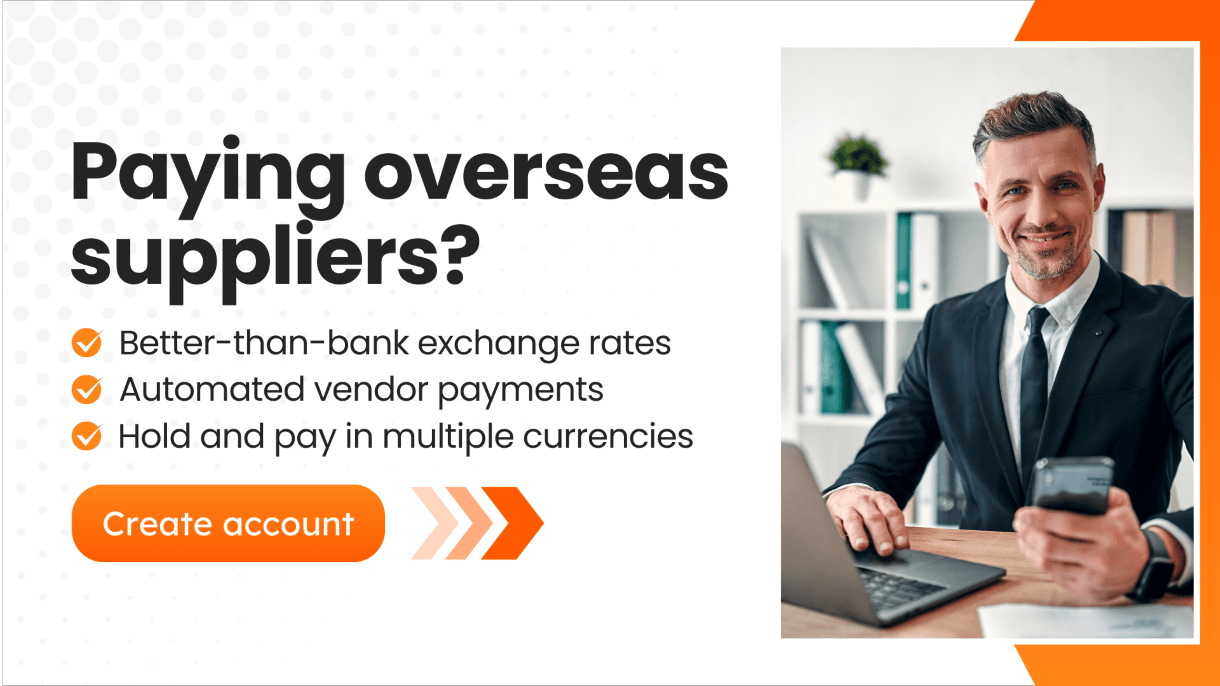Should You Pay Foreign Suppliers in Their Own Currency?
Managing supplier payments efficiently is an essential aspect of running a global business. When dealing with international suppliers, one of the key decisions is choosing the best way to pay overseas suppliers, including whether to pay in your currency or the supplier's local currency. This choice can significantly impact pricing, transaction fees, and financial risks.
While paying in your home currency may seem convenient, it can sometimes lead to higher costs due to unfavourable exchange rates or hidden markups applied by suppliers. On the other hand, paying in the supplier’s currency can help secure better pricing and build stronger relationships, though it also introduces foreign exchange risks.
By carefully considering the pros and cons of each approach, businesses can optimize their supplier payments, reduce unnecessary expenses, and improve overall financial efficiency in international transactions.
Advantages of paying in local currency
When managing supplier payments, choosing to pay overseas suppliers in their local currency can offer several benefits, from cost savings to improved business relationships. Businesses can streamline the supplier payment process, reduce hidden fees, and better manage foreign exchange risks by making payments in the supplier's preferred currency. Below are some key advantages of paying in local currency:
Reduced double conversions
Exchange rates can significantly impact overseas supplier payments, and businesses must find ways to avoid excessive rates. One of the most effective strategies is to pay suppliers in their local currency. When you pay a foreign supplier using your home currency, the payment often undergoes multiple conversions—typically first into an intermediary currency like USD, and then into the supplier’s local currency. Each conversion introduces additional fees and exposes your business to potentially unfavourable exchange rates. By paying directly in the supplier’s currency, you can reduce conversion costs and gain greater control over your international payment expenses.
By paying vendors directly in their currency, you avoid these double conversions, which helps reduce currency fluctuation risks and lowers overall transaction costs. This is especially important for cross-border transactions, where hidden fees and exchange markups can quickly add up.

Better exchange rates
Paying suppliers in local currency can help businesses save money on exchange rates. When a supplier sets prices in a foreign currency, they may add a buffer to account for fluctuations and conversion fees they incur. This means you could be paying more than necessary.
By handling currency conversion on your end—using a trusted foreign exchange provider or bank—you can often secure a more favourable exchange rate than what the supplier would apply. This can lead to significant cost savings when making frequent supplier payments in large volumes.
Streamlined payment process
Choosing the best way to pay an overseas supplier isn't just about cost and efficiency. Paying in the supplier's local currency simplifies the supplier payment process for both parties. Suppliers don't have to worry about exchange rate differences or unexpected shortfalls due to fluctuating conversion rates. They receive the expected amount, reducing disputes and delays in processing payments.
A smoother payment experience builds trust and strengthens business relationships. Reliable and transparent cross-border transactions can make suppliers more willing to offer better terms, faster shipping, or even priority service, ultimately benefiting your supply chain.
Mitigated foreign exchange risk
Currency fluctuations can impact the cost of doing business internationally. When suppliers set their prices in a foreign currency, they often increase prices to account for potential market shifts. However, if you pay overseas suppliers in their currency, you take control of foreign exchange risk.
This allows you to implement proactive strategies such as hedging, forward contracts, or multi-currency accounts to stabilize costs. Instead of suppliers inflating prices to cover currency risks, you manage those risks strategically, keeping costs predictable and minimizing potential financial losses.
Disadvantages of paying in local currency
While paying foreign suppliers in their local currency has several advantages, it also comes with certain challenges. Currency fluctuations, transaction fees, and operational complexities can impact costs and financial management. However, businesses can mitigate these risks using supplier payment solutions offering competitive exchange rates and efficient processing. Here are some potential drawbacks of paying foreign suppliers in their currency and how a robust payment system can help manage them.
Exchange rate fluctuations
One of the biggest risks of paying in a foreign currency is currency volatility. Exchange rates fluctuate constantly, and businesses may find themselves paying more than expected if rates move unfavourably between the invoice and payment dates. This unpredictability can make it difficult to forecast costs and manage budgets effectively.
Transaction fees and currency conversion costs
The cost of international wire transfers and foreign currency conversions can add up quickly. Banks and payment providers often charge extra fees for converting funds into a supplier's local currency, and many businesses do not have access to competitive exchange rates. These costs can eat into profit margins, making cross-border transactions more expensive than anticipated.
Operational complexity
Handling multiple currencies can complicate accounting and financial management. Businesses need to track exchange rates, maintain accurate financial records, and manage foreign currency accounts to avoid discrepancies. This additional workload can be time-consuming and requires expertise in international finance.
How to decide the best currency for supplier payments
Choosing the right currency for supplier payments requires careful evaluation of multiple factors. Businesses must assess their ability to handle foreign exchange, understand supplier preferences, and implement risk management strategies. Making the right decision can help optimize costs and improve efficiency in cross-border transactions. Here are key factors to consider when deciding whether to pay overseas suppliers in their local currency.
Business’s currency exchange capabilities
Before deciding how to make supplier payments, businesses should evaluate their access to competitive exchange rates and reliable payment providers. Not all businesses have access to the cheapest overseas money transfer options, and using traditional banks may result in high fees and unfavourable rates.
A robust payment system that offers fast money transfers and real-time exchange rate tracking can help businesses minimize conversion costs for currency pairs like CAD/USD. Partnering with a specialized payment provider ensures access to competitive exchange rates and cost-effective cross-border transactions, making it easier to manage international payments with greater efficiency.
Supplier preferences and their local economic conditions
Suppliers may strongly prefer receiving payments in their local currency, as it helps them avoid conversion fees and the risk of currency fluctuations. Additionally, the stability of a supplier's local economy and currency can impact their willingness to accept payments in a foreign currency.
Understanding these factors can help businesses determine the best way to pay overseas suppliers. In some cases, agreeing to pay in the supplier’s local currency can result in better pricing, improved trust, and stronger business relationships. Using a payment provider offering flexible currency options ensures businesses can meet supplier preferences while optimizing costs.
Hedging strategies and risk management
Currency fluctuations can significantly impact the cost of cross-border transactions, making it important to implement hedging strategies. Businesses that pay overseas suppliers in foreign currency should consider using forward contracts or currency hedging tools to protect themselves from sudden rate changes.
By working with a payment provider that offers hedging solutions, businesses can lock in favourable exchange rates in advance, reducing uncertainty and improving financial stability. This approach ensures businesses can maintain predictable costs while securing the cheapest overseas money transfer option.
How MTFX can help pay international suppliers in local currency
Paying international suppliers in their local currency offers several advantages, from securing better exchange rates to streamlining transactions. MTFX ensures businesses can pay overseas suppliers easily, securely, and at the most competitive rates. Here’s how we help optimize your international payments.
Best exchange rates
We provide highly competitive exchange rates to help businesses maximize cost savings. We secure favourable rates by leveraging a strong network of global banking partners. This ensures you get the best value when making supplier payments.
Secured payments
Ensuring the safety of your funds is our top priority in international transactions. We use advanced encryption technologies to safeguard every payment. This guarantees that your transactions are secure and reliable when you pay overseas suppliers.
Reduced costs
Eliminating double conversions and securing better rates helps businesses reduce payment costs. Lower transaction fees mean more savings for your company. This cost efficiency enhances financial stability when handling supplier payments.
Expert guidance
Managing foreign exchange risk requires the right strategy and insights. Our currency specialists offer expert guidance on risk management and hedging solutions. This ensures businesses make informed decisions when they pay overseas suppliers.
Efficient and streamlined process
A user-friendly platform makes initiating and tracking international payments seamless. Businesses can manage their supplier payments with ease and efficiency. This saves time, reduces errors, and improves overall payment management.
Lock-in exchange rates
Currency fluctuations can impact costs, but we offer rate-locking solutions. Businesses can secure favourable exchange rates in advance for predictable expenses. This helps stabilize cash flow and simplifies planning for supplier payments.
Access a wide range of currencies
Supporting multiple currencies makes paying overseas suppliers in their preferred currency easier. This eliminates conversion issues and strengthens supplier relationships. Expanding global reach becomes more efficient and cost-effective.

Improving efficiency in international supplier payments
Choosing the right currency for supplier payments is a critical decision that impacts costs, efficiency, and supplier relationships. While paying in a supplier’s local currency can lead to better pricing and smoother transactions, it also comes with risks, such as exchange rate fluctuations and additional fees. On the other hand, paying in your home currency may provide stability but could result in hidden costs.
The best approach depends on your business's ability to manage foreign exchange, your suppliers’ preferences, and risk management strategies. By leveraging a reliable payment solution, businesses can access competitive exchange rates, minimize transaction fees, and ensure a seamless payment experience for both parties.
Create an account on MTFX and start saving money and simplify your supplier payments with fast, cost-effective solutions.
FAQs
1. How to lower costs when paying foreign suppliers?
To reduce costs, businesses can use a specialized international payment provider that offers competitive exchange rates and lower transaction fees. Avoiding double currency conversions, negotiating rates with suppliers, and using payment solutions that minimize hidden fees can also help cut expenses.
2. What is the best way to pay overseas suppliers?
The best way to pay overseas suppliers depends on cost, speed, and security. Using a trusted international payments provider that offers local currency payments, competitive rates, and secure transactions is often the most cost-effective and efficient solution.
3. What are the common challenges in the supplier payment process?
Challenges include fluctuating exchange rates, high bank fees, delayed transfers, and complex compliance requirements. Businesses can simplify the supplier payment process using a digital payment platform that automates transactions and reduces costs.
4. How can I ensure secure supplier payments?
Using a regulated international payments provider with strong encryption and fraud protection measures ensures secure transactions. Verifying supplier details, using multi-layer authentication, and working with reliable supplier payment solutions enhance security.
5. How can I speed up cross-border transactions?
To ensure the fastest way to transfer money, businesses should use a payment platform that offers same-day or instant processing. Avoiding traditional wire transfers and using specialized supplier payment solutions can significantly reduce transfer times.
6. Should I pay overseas suppliers in their local currency or my home currency?
Paying in the supplier’s local currency often results in better pricing and avoids inflated exchange rate markups. However, businesses should assess their ability to manage foreign exchange risks before deciding how to pay overseas suppliers.
7. What are the hidden costs of international wire transfers?
The cost of international wire transfers includes bank fees, currency conversion charges, intermediary fees, and potential delays. Choosing a provider with transparent pricing and no hidden fees helps reduce unnecessary costs.
8. Are international payment gateways a good option for paying vendors?
International payment gateways provide a seamless and secure way to pay vendors worldwide. They support multiple currencies, offer fraud protection, and enable businesses to make cross-border payments quickly and efficiently.
Related Blogs
Stay ahead with fresh perspectives, expert tips, and inspiring stories.

Keep updated
Make informed decisions
Access tools to help you track, manage, and simplify your global payments.
Currency market updates
Track key currency movements and plan your transfers with confidence.
Create an account today
Start today, and let us take the hassle out of overseas transfers.
